Taxation Law Assignment: Australia, Masters Level, T3 2018
VerifiedAdded on 2023/01/19
|13
|1827
|72
Homework Assignment
AI Summary
This assignment solution addresses two key areas of Australian taxation law at the Masters level. Answer 1 focuses on calculating the net taxable income of a partnership business, Brekkie and Lunch and OZ Bottle Shop, detailing the inclusion and exclusion of various revenue and expense items based on the Income Tax Assessment Act 1997 (ITAA 1997). It provides a comprehensive breakdown of sales, cost of goods sold, operating expenses, and depreciation, culminating in the determination of taxable business income. Answer 2 examines Fringe Benefits Tax (FBT), specifically addressing whether payments made by an employer for an employee's child's private school fees and concessional rent attract FBT. It explains the relevant provisions of the Fringe Benefits Tax Act 1986 and applies them to the case facts, concluding that the employer is liable for FBT on both benefits. The solution includes detailed calculations of fringe benefits and references to relevant Australian Taxation Office (ATO) and legislation resources.
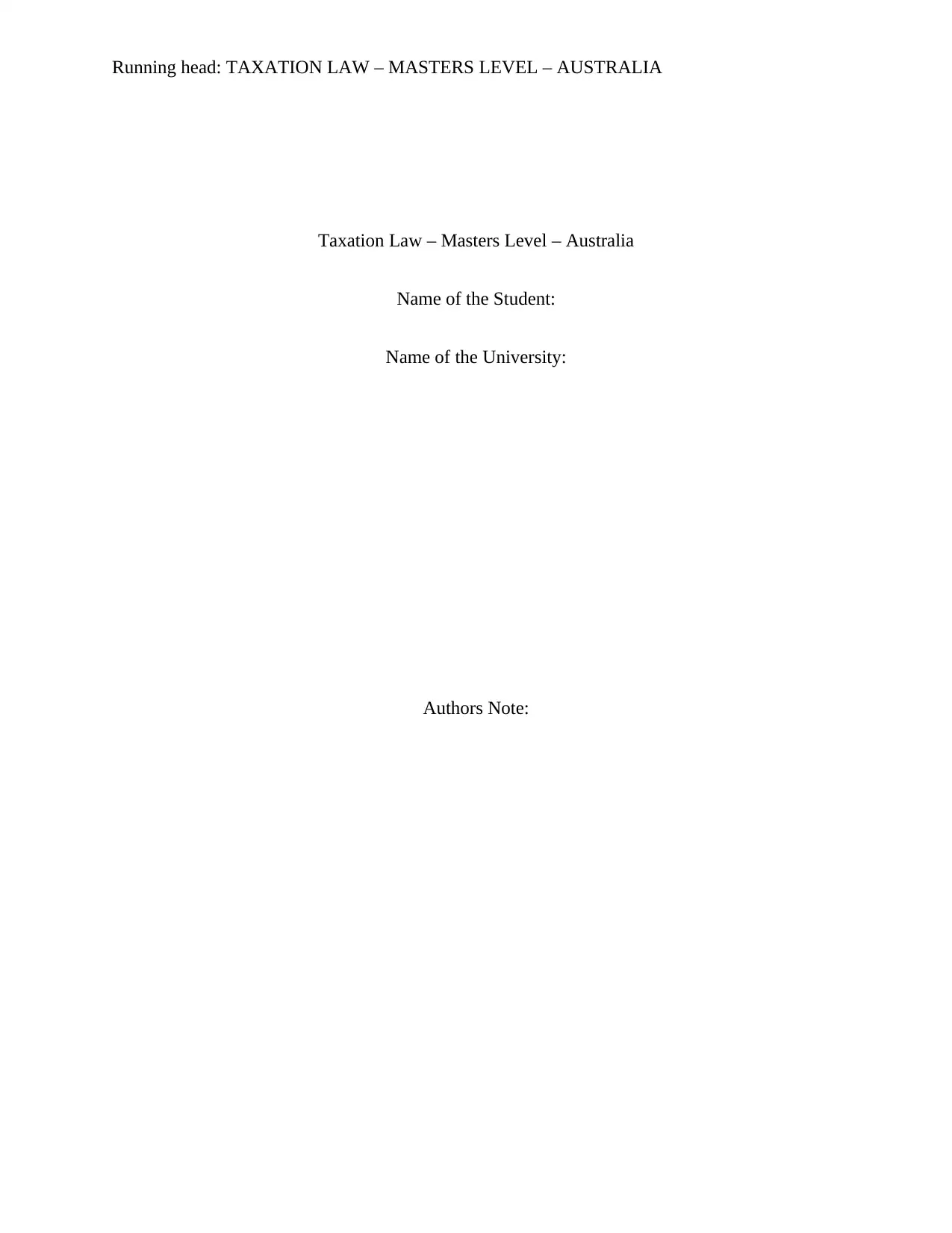
Running head: TAXATION LAW – MASTERS LEVEL – AUSTRALIA
Taxation Law – Masters Level – Australia
Name of the Student:
Name of the University:
Authors Note:
Taxation Law – Masters Level – Australia
Name of the Student:
Name of the University:
Authors Note:
Paraphrase This Document
Need a fresh take? Get an instant paraphrase of this document with our AI Paraphraser
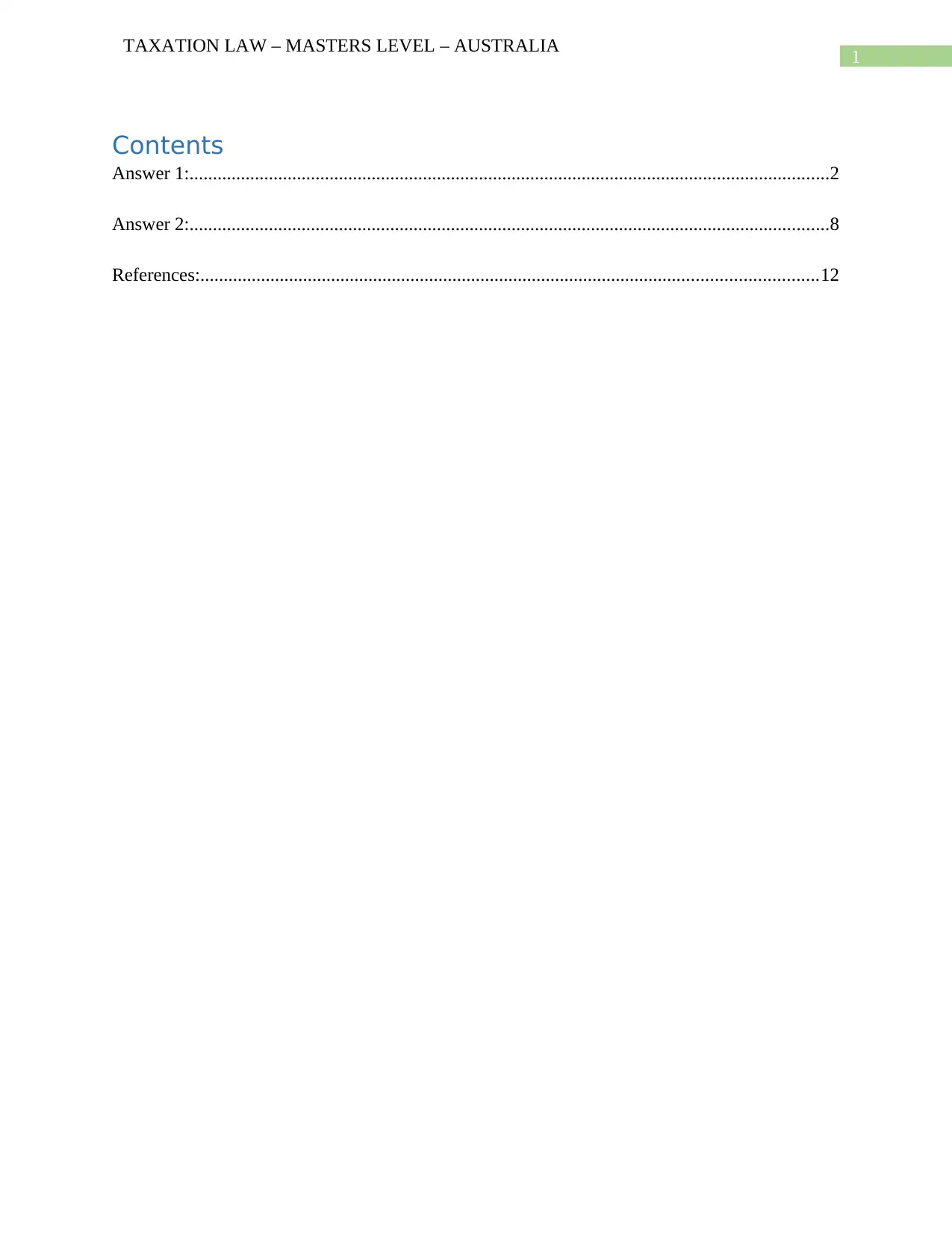
1
TAXATION LAW – MASTERS LEVEL – AUSTRALIA
Contents
Answer 1:.........................................................................................................................................2
Answer 2:.........................................................................................................................................8
References:....................................................................................................................................12
TAXATION LAW – MASTERS LEVEL – AUSTRALIA
Contents
Answer 1:.........................................................................................................................................2
Answer 2:.........................................................................................................................................8
References:....................................................................................................................................12
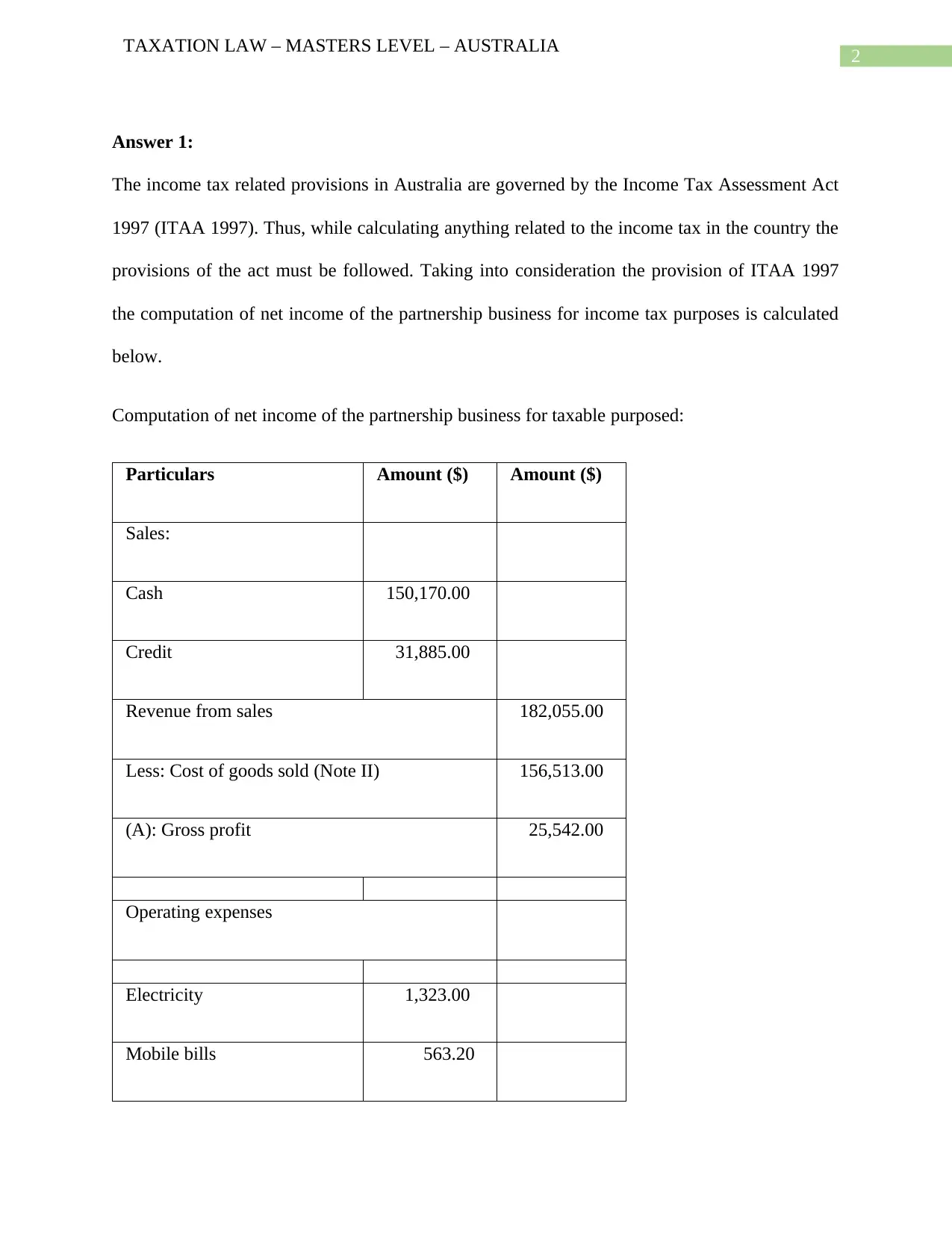
2
TAXATION LAW – MASTERS LEVEL – AUSTRALIA
Answer 1:
The income tax related provisions in Australia are governed by the Income Tax Assessment Act
1997 (ITAA 1997). Thus, while calculating anything related to the income tax in the country the
provisions of the act must be followed. Taking into consideration the provision of ITAA 1997
the computation of net income of the partnership business for income tax purposes is calculated
below.
Computation of net income of the partnership business for taxable purposed:
Particulars Amount ($) Amount ($)
Sales:
Cash 150,170.00
Credit 31,885.00
Revenue from sales 182,055.00
Less: Cost of goods sold (Note II) 156,513.00
(A): Gross profit 25,542.00
Operating expenses
Electricity 1,323.00
Mobile bills 563.20
TAXATION LAW – MASTERS LEVEL – AUSTRALIA
Answer 1:
The income tax related provisions in Australia are governed by the Income Tax Assessment Act
1997 (ITAA 1997). Thus, while calculating anything related to the income tax in the country the
provisions of the act must be followed. Taking into consideration the provision of ITAA 1997
the computation of net income of the partnership business for income tax purposes is calculated
below.
Computation of net income of the partnership business for taxable purposed:
Particulars Amount ($) Amount ($)
Sales:
Cash 150,170.00
Credit 31,885.00
Revenue from sales 182,055.00
Less: Cost of goods sold (Note II) 156,513.00
(A): Gross profit 25,542.00
Operating expenses
Electricity 1,323.00
Mobile bills 563.20
⊘ This is a preview!⊘
Do you want full access?
Subscribe today to unlock all pages.

Trusted by 1+ million students worldwide
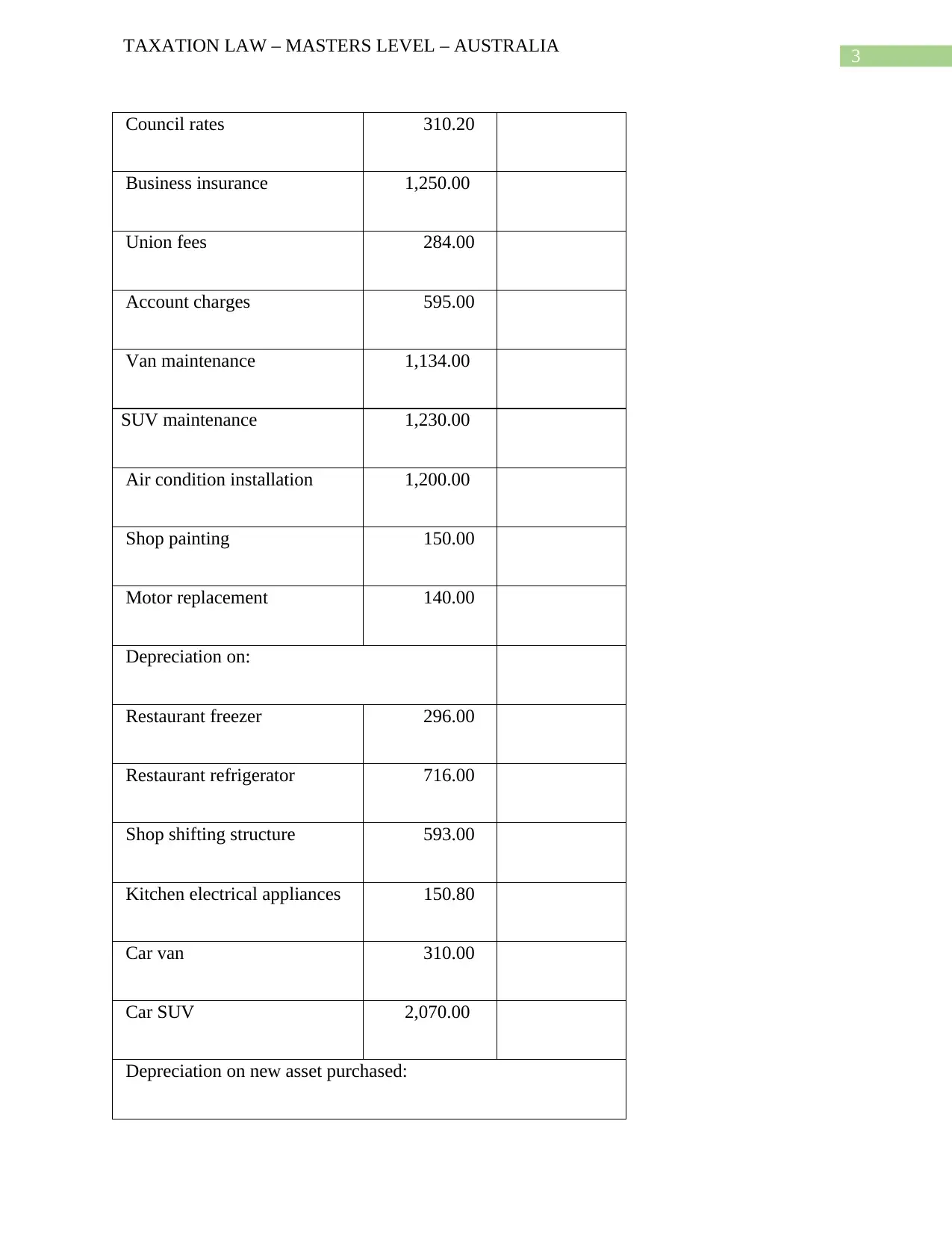
3
TAXATION LAW – MASTERS LEVEL – AUSTRALIA
Council rates 310.20
Business insurance 1,250.00
Union fees 284.00
Account charges 595.00
Van maintenance 1,134.00
SUV maintenance 1,230.00
Air condition installation 1,200.00
Shop painting 150.00
Motor replacement 140.00
Depreciation on:
Restaurant freezer 296.00
Restaurant refrigerator 716.00
Shop shifting structure 593.00
Kitchen electrical appliances 150.80
Car van 310.00
Car SUV 2,070.00
Depreciation on new asset purchased:
TAXATION LAW – MASTERS LEVEL – AUSTRALIA
Council rates 310.20
Business insurance 1,250.00
Union fees 284.00
Account charges 595.00
Van maintenance 1,134.00
SUV maintenance 1,230.00
Air condition installation 1,200.00
Shop painting 150.00
Motor replacement 140.00
Depreciation on:
Restaurant freezer 296.00
Restaurant refrigerator 716.00
Shop shifting structure 593.00
Kitchen electrical appliances 150.80
Car van 310.00
Car SUV 2,070.00
Depreciation on new asset purchased:
Paraphrase This Document
Need a fresh take? Get an instant paraphrase of this document with our AI Paraphraser
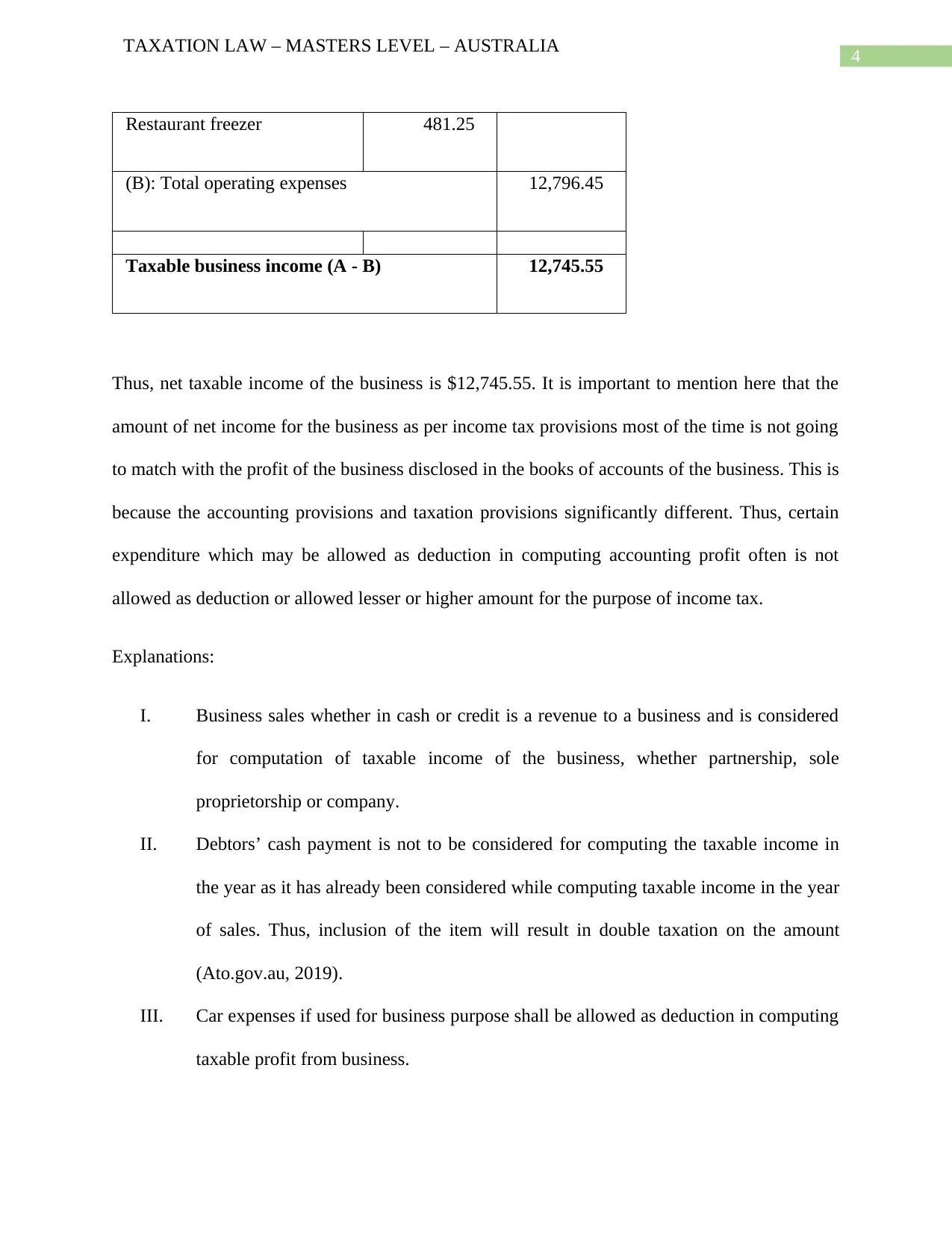
4
TAXATION LAW – MASTERS LEVEL – AUSTRALIA
Restaurant freezer 481.25
(B): Total operating expenses 12,796.45
Taxable business income (A - B) 12,745.55
Thus, net taxable income of the business is $12,745.55. It is important to mention here that the
amount of net income for the business as per income tax provisions most of the time is not going
to match with the profit of the business disclosed in the books of accounts of the business. This is
because the accounting provisions and taxation provisions significantly different. Thus, certain
expenditure which may be allowed as deduction in computing accounting profit often is not
allowed as deduction or allowed lesser or higher amount for the purpose of income tax.
Explanations:
I. Business sales whether in cash or credit is a revenue to a business and is considered
for computation of taxable income of the business, whether partnership, sole
proprietorship or company.
II. Debtors’ cash payment is not to be considered for computing the taxable income in
the year as it has already been considered while computing taxable income in the year
of sales. Thus, inclusion of the item will result in double taxation on the amount
(Ato.gov.au, 2019).
III. Car expenses if used for business purpose shall be allowed as deduction in computing
taxable profit from business.
TAXATION LAW – MASTERS LEVEL – AUSTRALIA
Restaurant freezer 481.25
(B): Total operating expenses 12,796.45
Taxable business income (A - B) 12,745.55
Thus, net taxable income of the business is $12,745.55. It is important to mention here that the
amount of net income for the business as per income tax provisions most of the time is not going
to match with the profit of the business disclosed in the books of accounts of the business. This is
because the accounting provisions and taxation provisions significantly different. Thus, certain
expenditure which may be allowed as deduction in computing accounting profit often is not
allowed as deduction or allowed lesser or higher amount for the purpose of income tax.
Explanations:
I. Business sales whether in cash or credit is a revenue to a business and is considered
for computation of taxable income of the business, whether partnership, sole
proprietorship or company.
II. Debtors’ cash payment is not to be considered for computing the taxable income in
the year as it has already been considered while computing taxable income in the year
of sales. Thus, inclusion of the item will result in double taxation on the amount
(Ato.gov.au, 2019).
III. Car expenses if used for business purpose shall be allowed as deduction in computing
taxable profit from business.
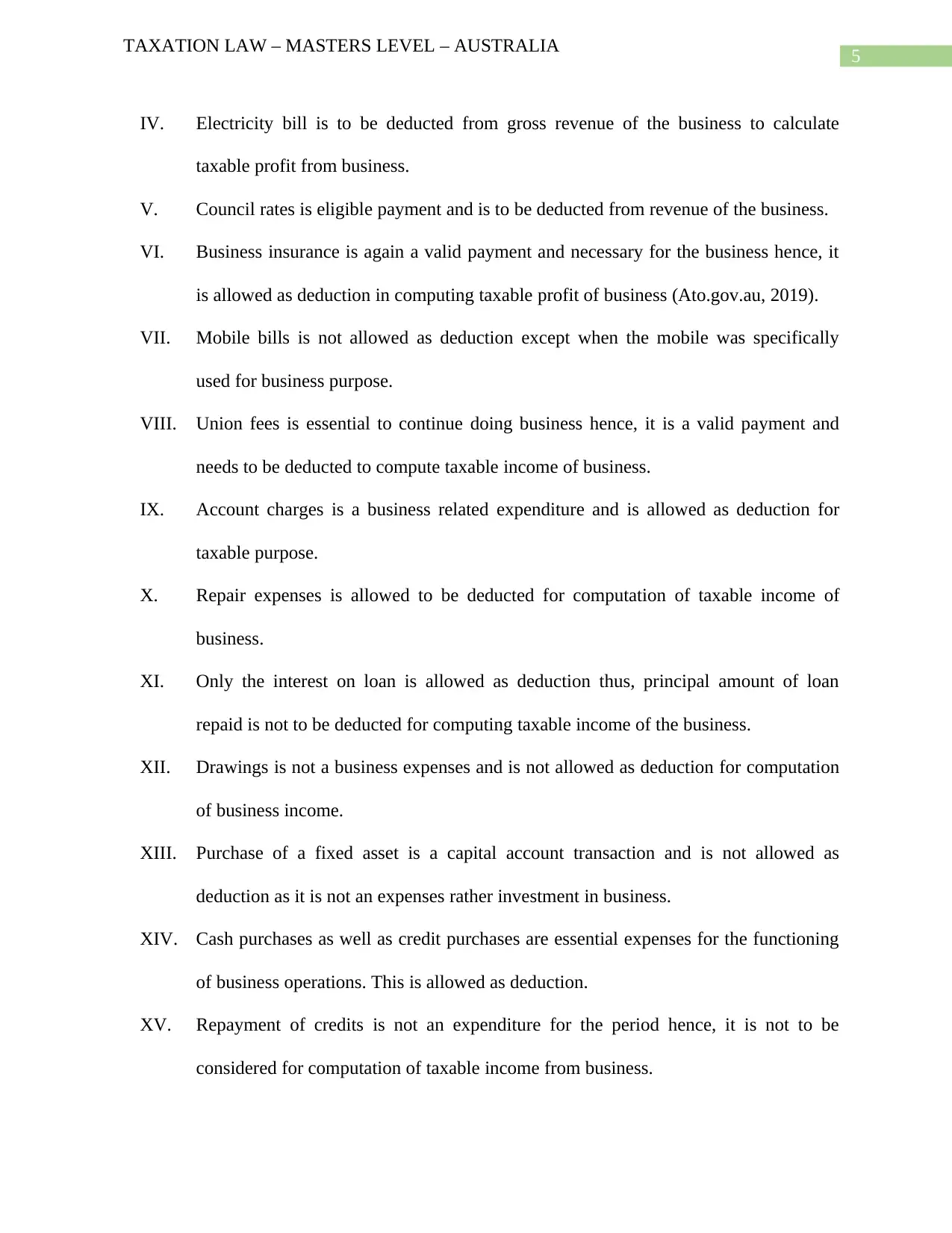
5
TAXATION LAW – MASTERS LEVEL – AUSTRALIA
IV. Electricity bill is to be deducted from gross revenue of the business to calculate
taxable profit from business.
V. Council rates is eligible payment and is to be deducted from revenue of the business.
VI. Business insurance is again a valid payment and necessary for the business hence, it
is allowed as deduction in computing taxable profit of business (Ato.gov.au, 2019).
VII. Mobile bills is not allowed as deduction except when the mobile was specifically
used for business purpose.
VIII. Union fees is essential to continue doing business hence, it is a valid payment and
needs to be deducted to compute taxable income of business.
IX. Account charges is a business related expenditure and is allowed as deduction for
taxable purpose.
X. Repair expenses is allowed to be deducted for computation of taxable income of
business.
XI. Only the interest on loan is allowed as deduction thus, principal amount of loan
repaid is not to be deducted for computing taxable income of the business.
XII. Drawings is not a business expenses and is not allowed as deduction for computation
of business income.
XIII. Purchase of a fixed asset is a capital account transaction and is not allowed as
deduction as it is not an expenses rather investment in business.
XIV. Cash purchases as well as credit purchases are essential expenses for the functioning
of business operations. This is allowed as deduction.
XV. Repayment of credits is not an expenditure for the period hence, it is not to be
considered for computation of taxable income from business.
TAXATION LAW – MASTERS LEVEL – AUSTRALIA
IV. Electricity bill is to be deducted from gross revenue of the business to calculate
taxable profit from business.
V. Council rates is eligible payment and is to be deducted from revenue of the business.
VI. Business insurance is again a valid payment and necessary for the business hence, it
is allowed as deduction in computing taxable profit of business (Ato.gov.au, 2019).
VII. Mobile bills is not allowed as deduction except when the mobile was specifically
used for business purpose.
VIII. Union fees is essential to continue doing business hence, it is a valid payment and
needs to be deducted to compute taxable income of business.
IX. Account charges is a business related expenditure and is allowed as deduction for
taxable purpose.
X. Repair expenses is allowed to be deducted for computation of taxable income of
business.
XI. Only the interest on loan is allowed as deduction thus, principal amount of loan
repaid is not to be deducted for computing taxable income of the business.
XII. Drawings is not a business expenses and is not allowed as deduction for computation
of business income.
XIII. Purchase of a fixed asset is a capital account transaction and is not allowed as
deduction as it is not an expenses rather investment in business.
XIV. Cash purchases as well as credit purchases are essential expenses for the functioning
of business operations. This is allowed as deduction.
XV. Repayment of credits is not an expenditure for the period hence, it is not to be
considered for computation of taxable income from business.
⊘ This is a preview!⊘
Do you want full access?
Subscribe today to unlock all pages.

Trusted by 1+ million students worldwide
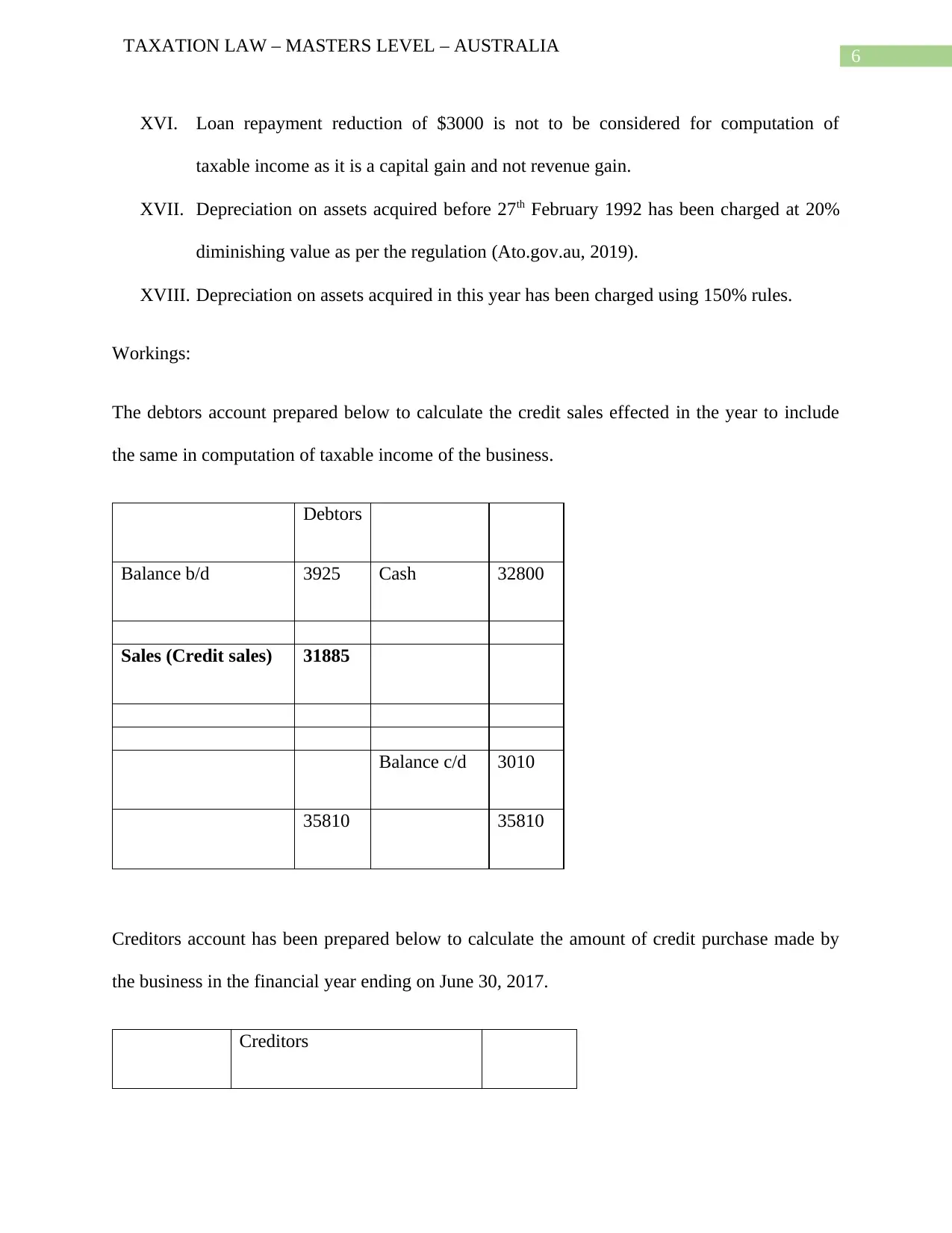
6
TAXATION LAW – MASTERS LEVEL – AUSTRALIA
XVI. Loan repayment reduction of $3000 is not to be considered for computation of
taxable income as it is a capital gain and not revenue gain.
XVII. Depreciation on assets acquired before 27th February 1992 has been charged at 20%
diminishing value as per the regulation (Ato.gov.au, 2019).
XVIII. Depreciation on assets acquired in this year has been charged using 150% rules.
Workings:
The debtors account prepared below to calculate the credit sales effected in the year to include
the same in computation of taxable income of the business.
Debtors
Balance b/d 3925 Cash 32800
Sales (Credit sales) 31885
Balance c/d 3010
35810 35810
Creditors account has been prepared below to calculate the amount of credit purchase made by
the business in the financial year ending on June 30, 2017.
Creditors
TAXATION LAW – MASTERS LEVEL – AUSTRALIA
XVI. Loan repayment reduction of $3000 is not to be considered for computation of
taxable income as it is a capital gain and not revenue gain.
XVII. Depreciation on assets acquired before 27th February 1992 has been charged at 20%
diminishing value as per the regulation (Ato.gov.au, 2019).
XVIII. Depreciation on assets acquired in this year has been charged using 150% rules.
Workings:
The debtors account prepared below to calculate the credit sales effected in the year to include
the same in computation of taxable income of the business.
Debtors
Balance b/d 3925 Cash 32800
Sales (Credit sales) 31885
Balance c/d 3010
35810 35810
Creditors account has been prepared below to calculate the amount of credit purchase made by
the business in the financial year ending on June 30, 2017.
Creditors
Paraphrase This Document
Need a fresh take? Get an instant paraphrase of this document with our AI Paraphraser
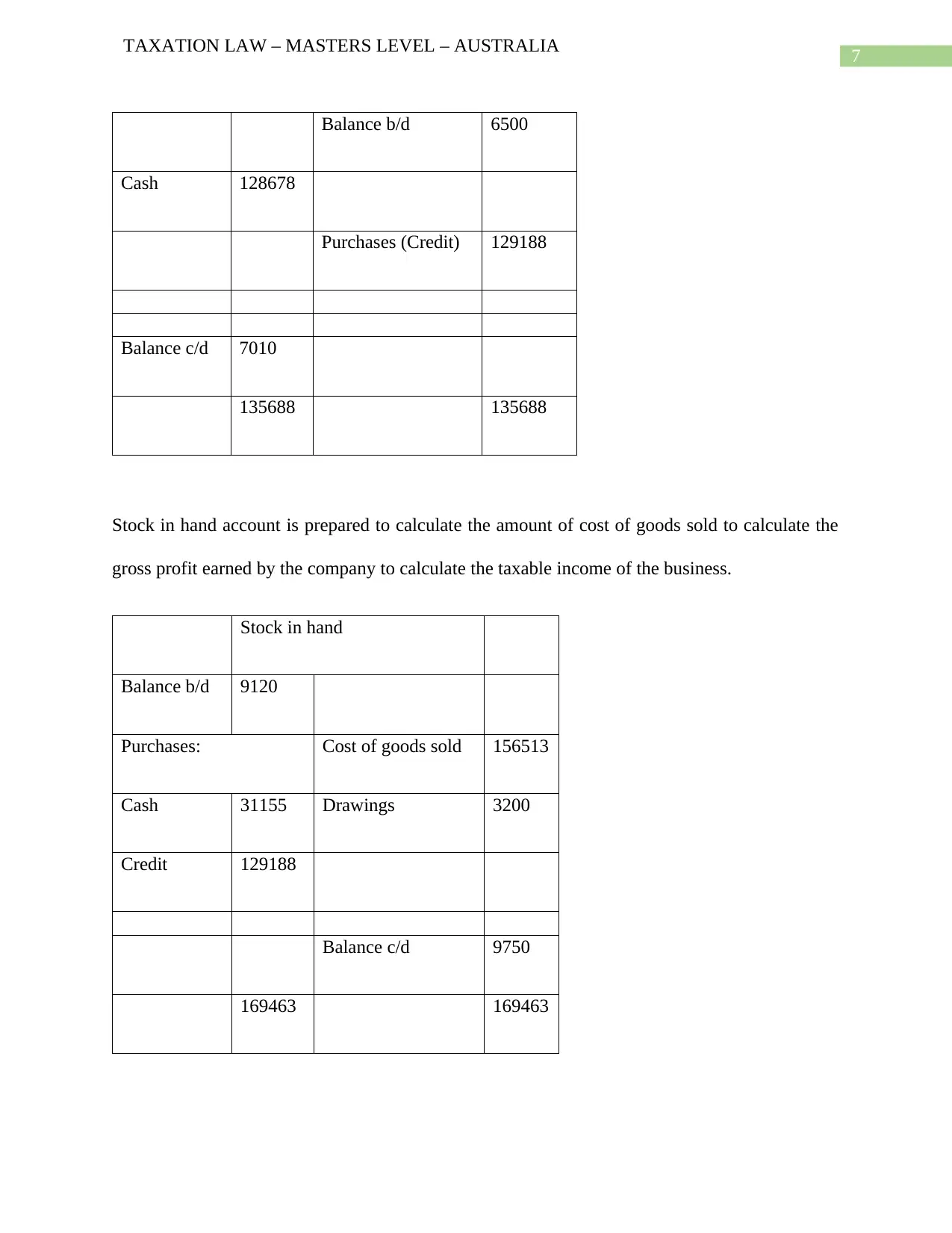
7
TAXATION LAW – MASTERS LEVEL – AUSTRALIA
Balance b/d 6500
Cash 128678
Purchases (Credit) 129188
Balance c/d 7010
135688 135688
Stock in hand account is prepared to calculate the amount of cost of goods sold to calculate the
gross profit earned by the company to calculate the taxable income of the business.
Stock in hand
Balance b/d 9120
Purchases: Cost of goods sold 156513
Cash 31155 Drawings 3200
Credit 129188
Balance c/d 9750
169463 169463
TAXATION LAW – MASTERS LEVEL – AUSTRALIA
Balance b/d 6500
Cash 128678
Purchases (Credit) 129188
Balance c/d 7010
135688 135688
Stock in hand account is prepared to calculate the amount of cost of goods sold to calculate the
gross profit earned by the company to calculate the taxable income of the business.
Stock in hand
Balance b/d 9120
Purchases: Cost of goods sold 156513
Cash 31155 Drawings 3200
Credit 129188
Balance c/d 9750
169463 169463
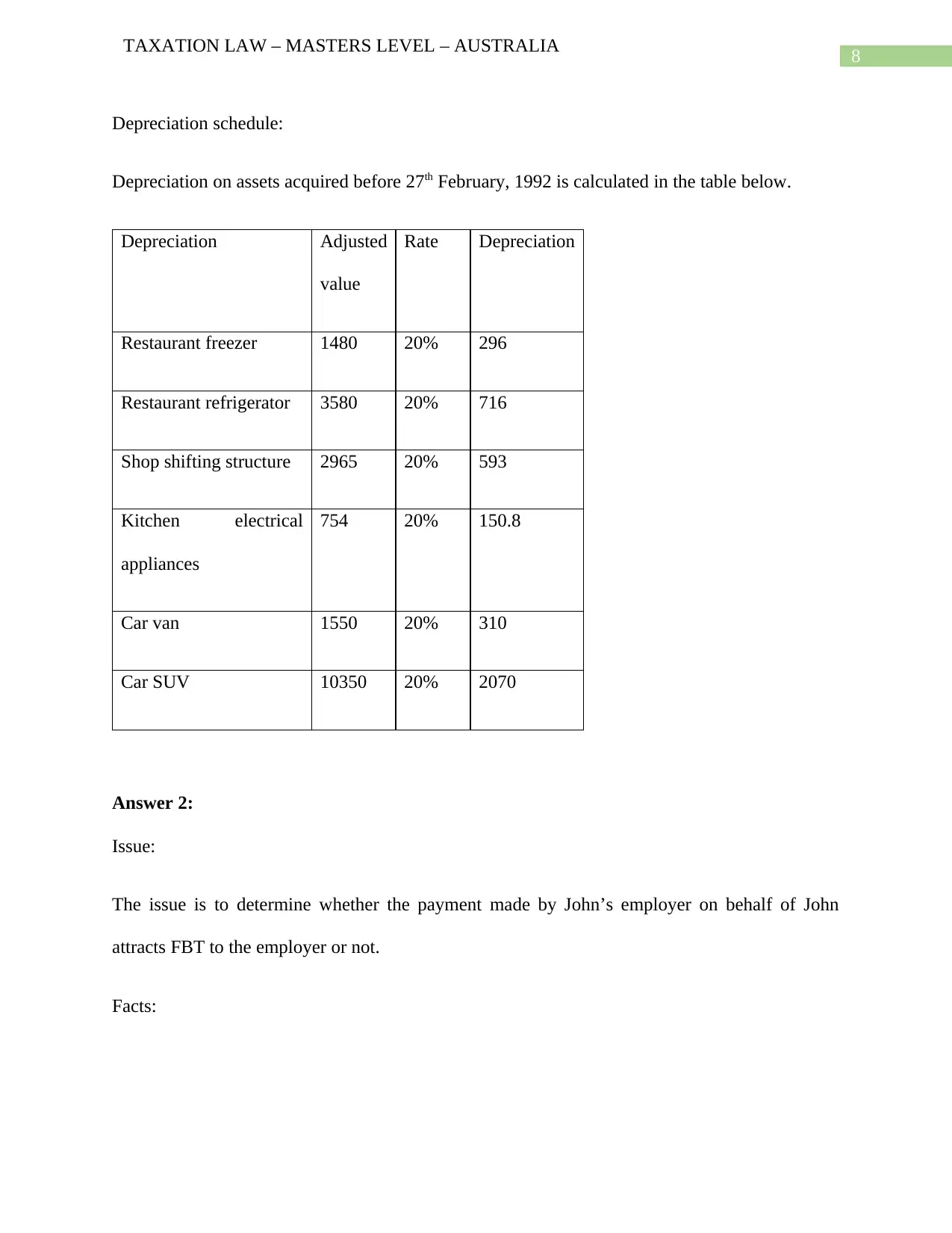
8
TAXATION LAW – MASTERS LEVEL – AUSTRALIA
Depreciation schedule:
Depreciation on assets acquired before 27th February, 1992 is calculated in the table below.
Depreciation Adjusted
value
Rate Depreciation
Restaurant freezer 1480 20% 296
Restaurant refrigerator 3580 20% 716
Shop shifting structure 2965 20% 593
Kitchen electrical
appliances
754 20% 150.8
Car van 1550 20% 310
Car SUV 10350 20% 2070
Answer 2:
Issue:
The issue is to determine whether the payment made by John’s employer on behalf of John
attracts FBT to the employer or not.
Facts:
TAXATION LAW – MASTERS LEVEL – AUSTRALIA
Depreciation schedule:
Depreciation on assets acquired before 27th February, 1992 is calculated in the table below.
Depreciation Adjusted
value
Rate Depreciation
Restaurant freezer 1480 20% 296
Restaurant refrigerator 3580 20% 716
Shop shifting structure 2965 20% 593
Kitchen electrical
appliances
754 20% 150.8
Car van 1550 20% 310
Car SUV 10350 20% 2070
Answer 2:
Issue:
The issue is to determine whether the payment made by John’s employer on behalf of John
attracts FBT to the employer or not.
Facts:
⊘ This is a preview!⊘
Do you want full access?
Subscribe today to unlock all pages.

Trusted by 1+ million students worldwide
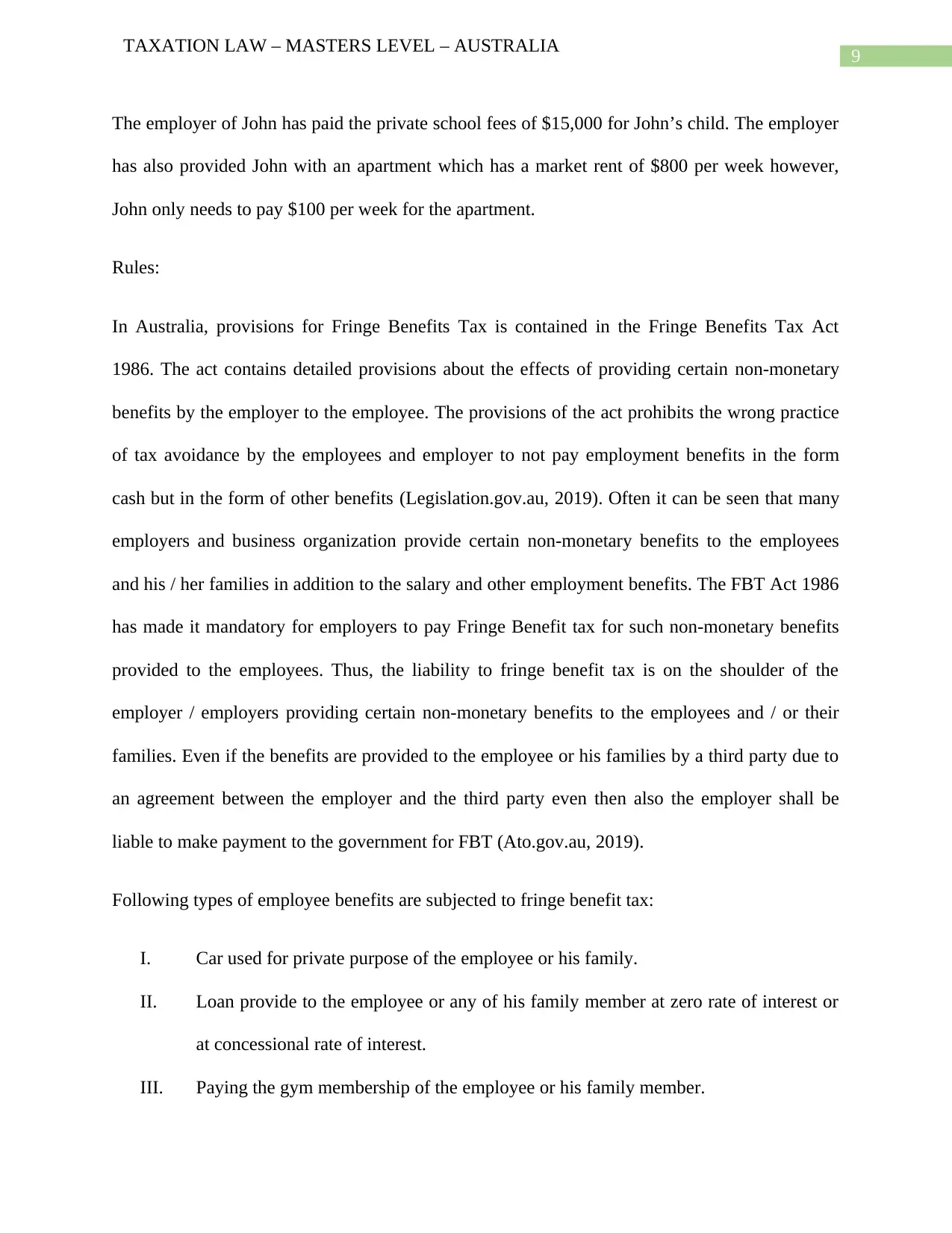
9
TAXATION LAW – MASTERS LEVEL – AUSTRALIA
The employer of John has paid the private school fees of $15,000 for John’s child. The employer
has also provided John with an apartment which has a market rent of $800 per week however,
John only needs to pay $100 per week for the apartment.
Rules:
In Australia, provisions for Fringe Benefits Tax is contained in the Fringe Benefits Tax Act
1986. The act contains detailed provisions about the effects of providing certain non-monetary
benefits by the employer to the employee. The provisions of the act prohibits the wrong practice
of tax avoidance by the employees and employer to not pay employment benefits in the form
cash but in the form of other benefits (Legislation.gov.au, 2019). Often it can be seen that many
employers and business organization provide certain non-monetary benefits to the employees
and his / her families in addition to the salary and other employment benefits. The FBT Act 1986
has made it mandatory for employers to pay Fringe Benefit tax for such non-monetary benefits
provided to the employees. Thus, the liability to fringe benefit tax is on the shoulder of the
employer / employers providing certain non-monetary benefits to the employees and / or their
families. Even if the benefits are provided to the employee or his families by a third party due to
an agreement between the employer and the third party even then also the employer shall be
liable to make payment to the government for FBT (Ato.gov.au, 2019).
Following types of employee benefits are subjected to fringe benefit tax:
I. Car used for private purpose of the employee or his family.
II. Loan provide to the employee or any of his family member at zero rate of interest or
at concessional rate of interest.
III. Paying the gym membership of the employee or his family member.
TAXATION LAW – MASTERS LEVEL – AUSTRALIA
The employer of John has paid the private school fees of $15,000 for John’s child. The employer
has also provided John with an apartment which has a market rent of $800 per week however,
John only needs to pay $100 per week for the apartment.
Rules:
In Australia, provisions for Fringe Benefits Tax is contained in the Fringe Benefits Tax Act
1986. The act contains detailed provisions about the effects of providing certain non-monetary
benefits by the employer to the employee. The provisions of the act prohibits the wrong practice
of tax avoidance by the employees and employer to not pay employment benefits in the form
cash but in the form of other benefits (Legislation.gov.au, 2019). Often it can be seen that many
employers and business organization provide certain non-monetary benefits to the employees
and his / her families in addition to the salary and other employment benefits. The FBT Act 1986
has made it mandatory for employers to pay Fringe Benefit tax for such non-monetary benefits
provided to the employees. Thus, the liability to fringe benefit tax is on the shoulder of the
employer / employers providing certain non-monetary benefits to the employees and / or their
families. Even if the benefits are provided to the employee or his families by a third party due to
an agreement between the employer and the third party even then also the employer shall be
liable to make payment to the government for FBT (Ato.gov.au, 2019).
Following types of employee benefits are subjected to fringe benefit tax:
I. Car used for private purpose of the employee or his family.
II. Loan provide to the employee or any of his family member at zero rate of interest or
at concessional rate of interest.
III. Paying the gym membership of the employee or his family member.
Paraphrase This Document
Need a fresh take? Get an instant paraphrase of this document with our AI Paraphraser
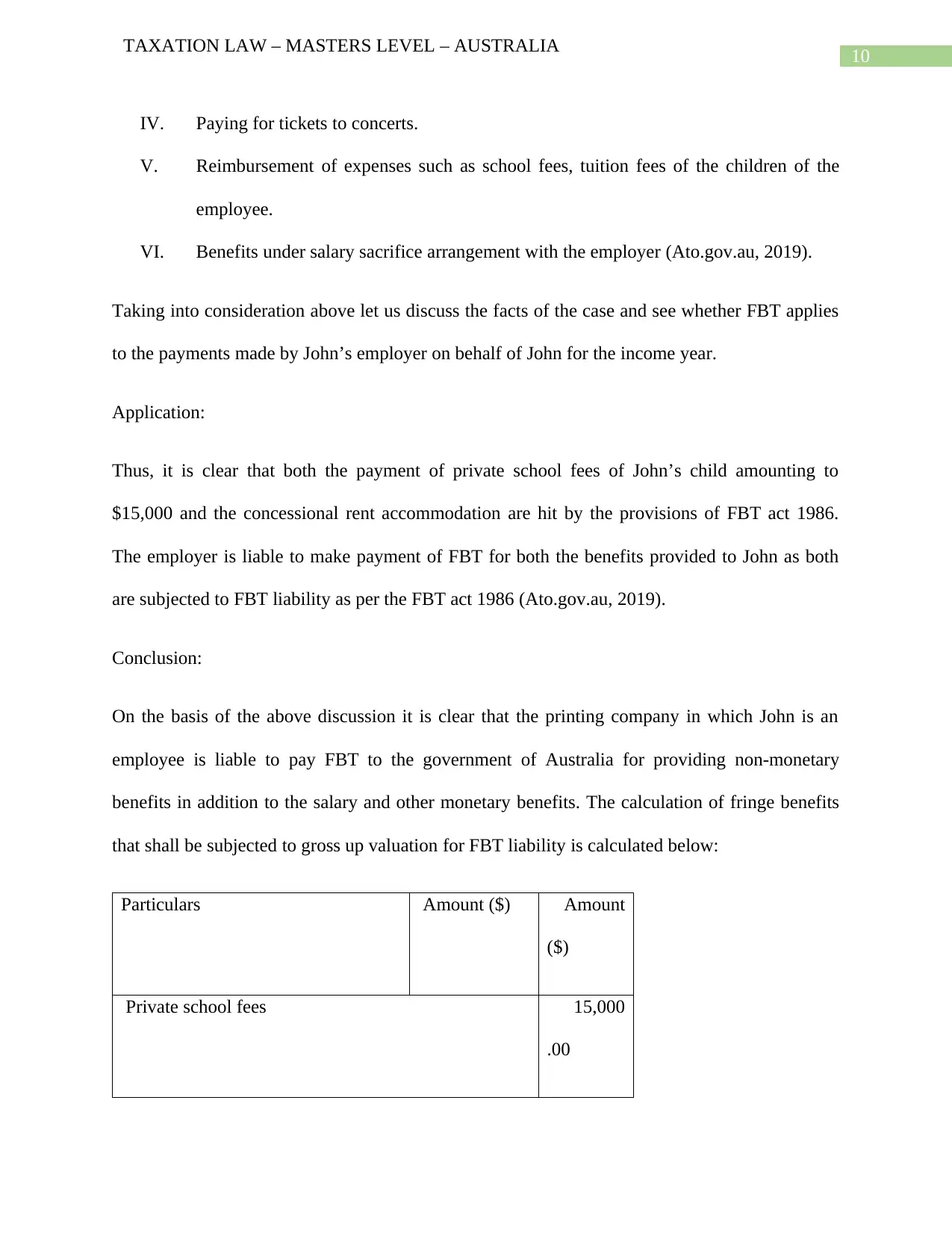
10
TAXATION LAW – MASTERS LEVEL – AUSTRALIA
IV. Paying for tickets to concerts.
V. Reimbursement of expenses such as school fees, tuition fees of the children of the
employee.
VI. Benefits under salary sacrifice arrangement with the employer (Ato.gov.au, 2019).
Taking into consideration above let us discuss the facts of the case and see whether FBT applies
to the payments made by John’s employer on behalf of John for the income year.
Application:
Thus, it is clear that both the payment of private school fees of John’s child amounting to
$15,000 and the concessional rent accommodation are hit by the provisions of FBT act 1986.
The employer is liable to make payment of FBT for both the benefits provided to John as both
are subjected to FBT liability as per the FBT act 1986 (Ato.gov.au, 2019).
Conclusion:
On the basis of the above discussion it is clear that the printing company in which John is an
employee is liable to pay FBT to the government of Australia for providing non-monetary
benefits in addition to the salary and other monetary benefits. The calculation of fringe benefits
that shall be subjected to gross up valuation for FBT liability is calculated below:
Particulars Amount ($) Amount
($)
Private school fees 15,000
.00
TAXATION LAW – MASTERS LEVEL – AUSTRALIA
IV. Paying for tickets to concerts.
V. Reimbursement of expenses such as school fees, tuition fees of the children of the
employee.
VI. Benefits under salary sacrifice arrangement with the employer (Ato.gov.au, 2019).
Taking into consideration above let us discuss the facts of the case and see whether FBT applies
to the payments made by John’s employer on behalf of John for the income year.
Application:
Thus, it is clear that both the payment of private school fees of John’s child amounting to
$15,000 and the concessional rent accommodation are hit by the provisions of FBT act 1986.
The employer is liable to make payment of FBT for both the benefits provided to John as both
are subjected to FBT liability as per the FBT act 1986 (Ato.gov.au, 2019).
Conclusion:
On the basis of the above discussion it is clear that the printing company in which John is an
employee is liable to pay FBT to the government of Australia for providing non-monetary
benefits in addition to the salary and other monetary benefits. The calculation of fringe benefits
that shall be subjected to gross up valuation for FBT liability is calculated below:
Particulars Amount ($) Amount
($)
Private school fees 15,000
.00
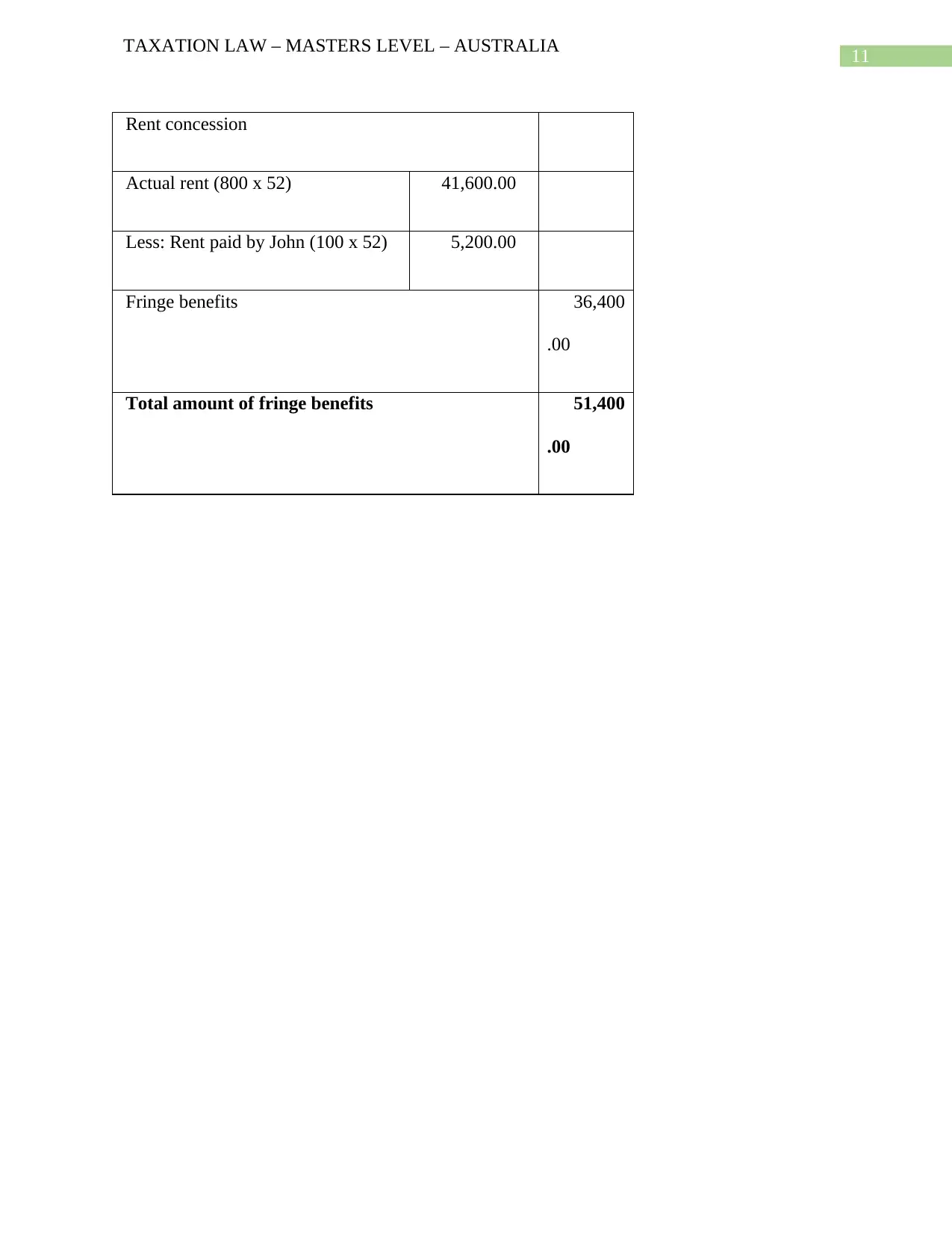
11
TAXATION LAW – MASTERS LEVEL – AUSTRALIA
Rent concession
Actual rent (800 x 52) 41,600.00
Less: Rent paid by John (100 x 52) 5,200.00
Fringe benefits 36,400
.00
Total amount of fringe benefits 51,400
.00
TAXATION LAW – MASTERS LEVEL – AUSTRALIA
Rent concession
Actual rent (800 x 52) 41,600.00
Less: Rent paid by John (100 x 52) 5,200.00
Fringe benefits 36,400
.00
Total amount of fringe benefits 51,400
.00
⊘ This is a preview!⊘
Do you want full access?
Subscribe today to unlock all pages.

Trusted by 1+ million students worldwide
1 out of 13
Related Documents
Your All-in-One AI-Powered Toolkit for Academic Success.
+13062052269
info@desklib.com
Available 24*7 on WhatsApp / Email
![[object Object]](/_next/static/media/star-bottom.7253800d.svg)
Unlock your academic potential
Copyright © 2020–2025 A2Z Services. All Rights Reserved. Developed and managed by ZUCOL.





